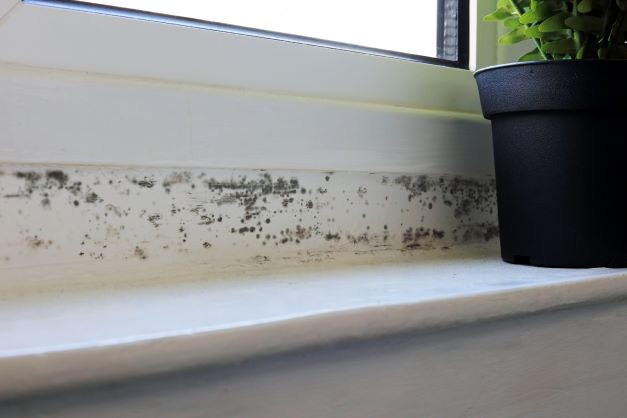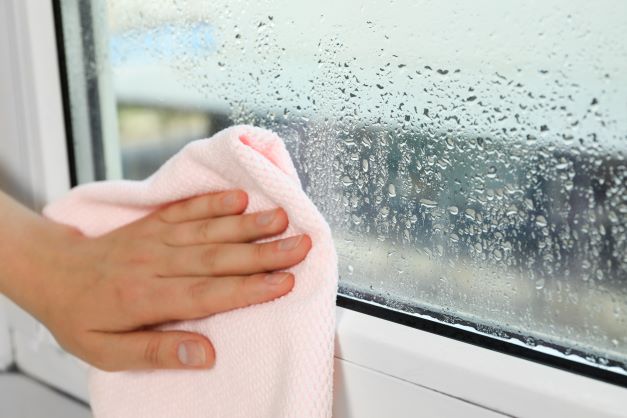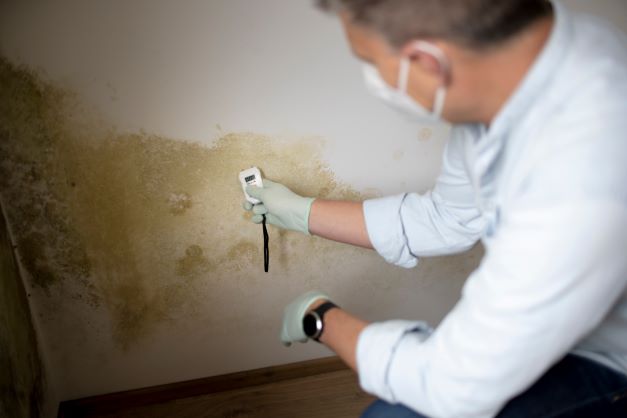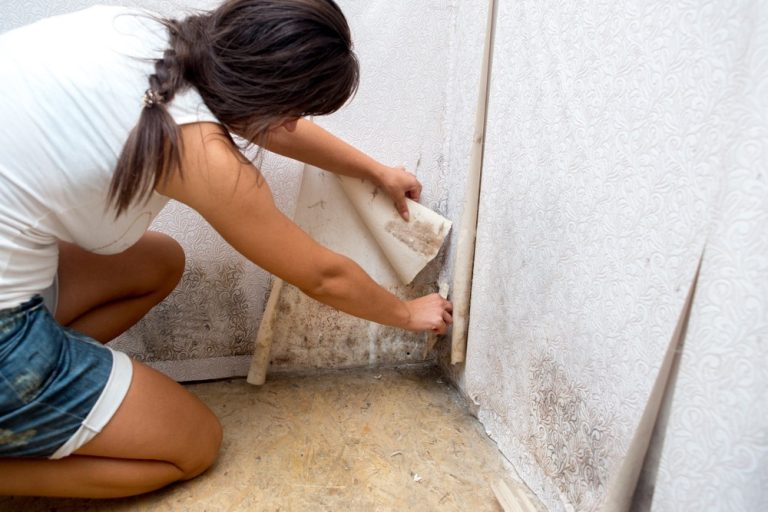Damp can cause a great deal of stress for many homeowners. As well as making a house feel cold, uncomfortable and unhealthy, it can destroy decor, ruin furniture and aggravate allergies and respiratory problems like asthma.
If it isn’t dealt with, it can cause severe structural damage to a building, which can be extremely dangerous. The moisture can weaken structural timbers and lead to other related problems, such as woodworm, dry rot and wet rot.
But what are the signs of damp in your house? If you suspect you have dampness, how do you get rid of it? And how serious is damp in a house?
In this article, we’ll explain how to spot the different signs of damp, advise on what you can do to rectify the problem and offer some damp proofing ideas to help prevent it from occurring in the first place.
- What are the signs of damp in a house?
- What causes damp in a house?
- How to identify rising damp
- How to identify penetrating damp
- How do I know if I have damp or condensation?
- How to fix damp internal walls?
- How much does it cost to fix damp in a house?
- How do I get rid of damp in my house?
- Summary
What are the signs of damp in a house?

The tell-tale signs of rising dampness in a house include;
- a musty smell,
- cold, wet, or mouldy walls, floors, or ceilings
- excessive water droplets on windows
- rotting skirting boards
- lifting or peeling wallpaper
- discoloured patches on walls or plaster
- increased humidity in the air.
The early stages of damp can usually be identified by a musty smell — in which case, you should examine your house to locate the problem by feeling for wet patches, looking underneath the flooring and listening for a crunching sound as you move your hand over walls (as this could be plaster salts that have been washed out of the bricks and into the plaster). The best way to check for damp, though, is to call in an expert surveyor.
Continue reading to find out how to tell the difference between rising damp, penetrating damp and condensation, what the possible cause could be and what you need to do to treat each one.
What causes damp in a house?
Dampness in a house is caused by water or moisture working its way into a building via walls, ceilings, floors, or windows.
This can happen in numerous ways, including:
- A damaged or non-existent damp-proof course, which means moisture can rise from the ground
- A leaking appliance, such as a dishwasher or washing machine
- Blocked or damaged guttering
- Burst or leaky pipes and overflows
- Inadequate ventilation, meaning damp can arise from everyday household tasks, such as cooking, drying wet clothes indoors, bathing and showering
- Leaking windows
- Missing or broken roof tiles that allow water to get in through the roof
- Porous bricks
How to identify rising damp
Rising damp occurs when external moisture is drawn up from the ground through the brickwork. To prevent rising damp new buildings should have a damp-proof course built into the walls about 15 centimetres above ground level and a damp-proof membrane underneath the floor. However, these can be damaged or worn over time, making them ineffective.
If you see any of the following signs of damp on the ground floor of your house, it may be rising:
- Damaged or rotting skirting boards or plaster
- Damp patches at the base of a wall, which gradually move upwards
- Peeling paint or wallpaper
- Rusty nails or screws on skirting boards
- Wet and lifting floor coverings
- White, powdery salt marks on walls and plaster
- Yellow or brown ‘tide marks’ about one metre above floor level (though they can be higher)
How to identify penetrating damp
Penetrating damp is caused when external problems with a building lead to water or moisture finding its way in from the outside. This means you might also see signs of damp on external walls, such as damaged brickwork or moss and algae.
Some of the most common external problems which lead to penetrating damp include:
- Blocked or damaged guttering
- Broken or porous brickwork
- Burst or leaky pipes and overflows
- Cracked or defective external render
- Damaged window and door seals
- Defective roof coverings
- Missing roof tiles
- Poorly maintained drains
- Tired or defective mortar joints
- Vegetation interfering with the rainwater system and wall surfaces
Tackling how to treat penetrating damp depends on what’s causing the damp problems. For example, a leaky pipe is easier to deal with than porous brickwork, which will be more widespread.
Some of the signs of penetrating damp are similar to rising damp. However, you’ll usually notice that the moisture moves horizontally through the walls rather than up:
- Bubbling plaster or wallpaper lifting or peeling
- Cracks or damage to the external walls or guttering
- Damage to the wallpaper or plaster higher up the walls
- Damp patches in various places on the walls and ceiling
How do I know if I have damp or condensation?

Condensation is a type of damp, which occurs when air condenses on cold surfaces and creates water. It’s often caused by carrying out everyday household tasks without having adequate heating or ventilation in your home.
If you experience any of the below around your home, it could indicate a condensation problem:
- A lingering musty smell
- Black mould around window frames or on walls, particularly behind furniture on external walls
- Damp patches on walls
- Excessive moisture or water droplets on cold surfaces like windows, cold walls and tiles
- Increased humidity
- Water running down walls in rooms where there’s steam, such as bathrooms and kitchens
How to fix damp internal walls?
If you find small signs of damp on a wall or notice some black mould around the window in the bathroom, it can be tempting to put it on the back burner until you have time to fix it. But not dealing with it immediately can lead to more serious structural problems to your house that you may find you won’t be able to claim on your home insurance. This is because damp or mould treatment is often seen as “general wear and tear” that can occur in a property, rather than an unexpected issue that can be covered by insurance.
When you buy a home insurance policy, you’ll usually need to agree that the property is in a good condition and declare whether or not there’s damp. If there is, and you don’t declare it, it will mean the property is not in a good condition, and your policy will be invalidated. So, it’s always best to deal with the problem as soon as possible.
The first thing you need to do is to diagnose the damp problems correctly. Different types of damp need to be treated in different ways, and if you use the wrong treatment, it could lead to more issues and become more expensive to fix. Once you’ve diagnosed the problem, you can decide whether to attempt to fix it yourself or hire a professional.
While most damp problems do require help from a damp specialist, some can be fixed by some simple home maintenance:
Eliminate condensation by improving the ventilation in your home
It’s easy to do this by:
- Cleaning out airbricks in the walls
- Cooking with pans that have lids
- Hanging washing outside or in a room with the door closed and window open
- Installing extractor fans in bathrooms and kitchens
- Opening more windows
- Running a bath with cold water first, then hot (this reduces up to 90 per cent of the steam that leads to condensation)
- Using dehumidifiers
- Venting your tumble dryer to the outside
Tackling rising damp and penetrating damp
This is less easy to do, but as long as you’ve identified the damp problem correctly, you can try:
- Locating your home’s damp-proof course and checking that it’s not buried beneath paths and flower beds
- Repairing or replacing cracked render
- Replacing or repairing missing roof tiles
- Replacing porous bricks or painting them with silicone water-repellent paint
- Unclogging and repairing or replacing gutters and drainpipes that are blocked or leaking to prevent moisture and water from penetrating the outside walls
If you’re certain you can locate and rectify the source of the damp, you have a good chance of being able to resolve the problem yourself. However, if you’re unsure of what type of damp it is, what caused it, the extent of the damage or the solution you need, you should speak to a reputable contractor.
How much does it cost to fix damp in a house?

Fixing minor damp problems in your home yourself can be relatively inexpensive. But — as mentioned above — you need to make sure you’ve identified the problem, cause and solution accurately. If the damp isn’t going away after you’ve tried the above fixes, or you’ve realised the problem is too big to rectify yourself, you’ll need to hire an expert. This may seem expensive at the time, but it will be worth it in the long run, as damp that leads to rot can cause structural damage, which is much more expensive to fix.
As stated earlier, the extent of the problem depends on what the cause is. One leaking pipe is less costly to repair than replacing multiple porous bricks. Some of the other, more expensive solutions a professional may suggest include:
- Fitting or replacing a cavity tray to prevent water from outside reaching the inner wall
- Fitting or replacing a damp-proof course and membrane, which involves materials or chemicals being injected into the wall to create a water-proof barrier
The cost of damp-proofing your house depends on factors such as its size, age and whether there are any existing damp issues. However, to give you an idea, a good quality extractor fan is roughly £500, and a remedial damp-proof course plus related plasterwork for a flat, five-metre wall costs from £1,200.
When hiring a professional, costs can run into thousands of pounds, so it’s well worth shopping around for at least three quotes before hiring someone. When choosing a tradesperson, you should consider their qualifications (Certified Surveyor in Remedial Treatments (CSRT) and Certified Surveyor in Structural Waterproofing (CSSW) qualifications assure that the survey and treatments are being carried out to the highest industry standards), whether they’re members of recognised industry associations like the Property Care Association (PCA), how many positive online reviews they have and whether they’re able to competently answer the questions you have and tailor their services to suit your needs. It’s also a good idea to ask for recommendations from friends, family, neighbours and local community groups.
How do I get rid of damp in my house?
As most home insurance policies don’t cover damp, it’s wise to make sure you take damp proofing measures to prevent it from occurring in the first place.
Here are some damp proofing methods you can use:
- Allow air to circulate by leaving gaps between walls and furniture
- Dry clothes outside when possible and keep lids on pans when cooking
- Once you’ve rectified a damp issue, remove any mould that’s built up with a cloth and soapy water or anti-mould spray
- Open windows and vents and use extractor fans
- Maintain guttering, drains and roof tiles
- Regularly check the inside and outside of your building, paying particular attention to bathroom and kitchen walls and behind furniture
- Remove moss and algae that’s growing on external walls
Summary
There are three different types of damp: Rising damp, penetrating damp and condensation. Common signs of rising damp include damaged or rotting skirting boards or plaster, damp patches at the base of a wall, which gradually move upwards, peeling wallpaper and rotting skirting boards. Some of the signs of penetrating damp are similar to rising damp — such as peeling wallpaper and damp patches on the walls — however, you’ll usually notice that the moisture moves horizontally through the walls rather than up. If you experience a lingering musty smell, black mould around window frames or on walls, excessive water droplets on windows and walls or increased humidity, it could indicate a condensation problem.
It’s important to spot damp and deal with it immediately, as it can lead to more serious structural problems and external defects to your house that you may find you won’t be able to claim on your home insurance. Different types of damp need to be treated in different ways, though, and if you use the wrong treatment, it could lead to more issues and become more expensive to fix. Once you’ve diagnosed the problem, you can decide whether to attempt to fix it yourself or hire a professional who can advise on how to prevent damp reappearing in the future.
Need help finding fully comprehensive home insurance cover? We pride ourselves on our truly personal service, so get in touch with A-Plan today, or visit our website.
Also read:
House viewing checklist: What to look out for
Substinence: How to spot it and what to do

